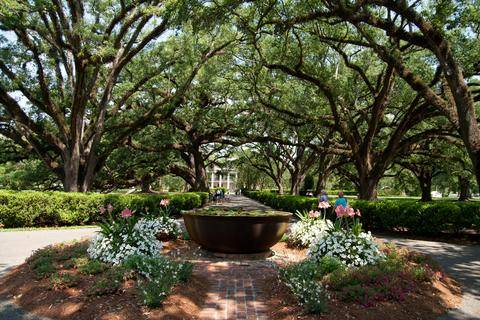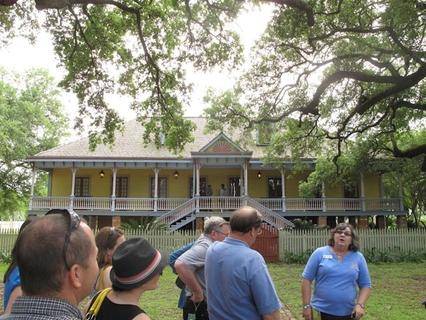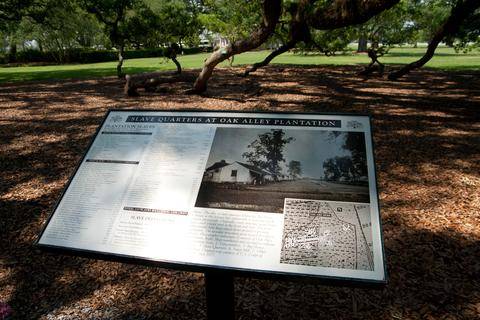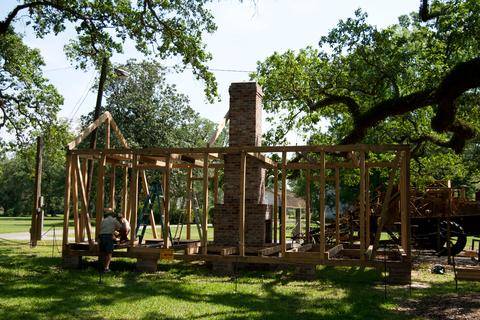The Politics of Plantations
Laura and Oak Alley Plantation on the Great River Road
Caroline Bressey

In her seminal 1982 essay White Woman Listen!, Hazel Carby argued that feminist scholars needed to address the role of women in histories of slavery and empire. This was not a call for more stories of women's campaigns against the slave trade. Carby demanded that scholars think more carefully about the levels of exploitation that occurred between women, not simply to women, in these systems. The role of white women in the management of plantation slavery is at the heart of Laura. A creole plantation along the Mississippi river in Louisiana, Laura was maintained and managed by women over four generations. A painful example of Carby's thesis is given in a story about the plantation's second female manager and owner Elisabeth Duparc who brought a 'stock' of female slaves from New Orleans to bring forth a 'crop of children' to labour in her sugar fields.

Laura plantation is one of a number of plantations that survive along 'Plantation Parade' on the Mississippi between Baton Rouge and New Orleans. The heritage title hints at the romantic nostalgia of antebellum histories that dominate the narratives of both Laura and Oak Alley Plantation. Built between 1837 and 1839 Oak Alley perfectly fits the imagination of an antebellum 'Big House', partly because it has often been used to represent one. The home's white columns and oak tree avenues have been filmed for 'Hush, Hush, Sweet Charlotte' staring Bette Davis, 'Interview with a Vampire' and Beyonce's 'Déjà vu' music video in which the miseries and sexual violence of slavery form an unacknowledged and uncomfortably bizarre foundation for a song about the power of unconscious memories.

For the tour guide on my visit, Oak Alley is a love story realised in bricks and mortar, but there is little discussion of how this 'love story' moulded the lives of the enslaved men and women who worked on the home's construction for the two years it took to build. Although the enslaved are mentioned as builders, skilled craftsmen and discreet servants, they are rarely named. As opposed to the detailed genealogical histories of the 'Big House' the men and women who worked in it are presented as a largely unknowable and indistinguishable crowd - despite the list of 'slave names' that is posted in the grounds. There is great admiration expressed for the home's design and the emphasis placed on its elegance of practicality, but the Big House's thoughtful designs are not compared to the wooden shacks the enslaved lived in without a veranda to keep them cool after a day's sweat in the fields.

In 1866 Oak Alley was sold at auction to John Armstrong, a number of owners followed but by the 1920s the house fell into a state of decline. Any slave cabins that remained when the house was bought by Andrew and Josephine Stewart in 1925 were torn down during their residence. Although they were dedicated to restoring the Big House, this did not include the homes of the enslaved Africans who had lived on the site. Oak Alley is now reconstructing a 'slave cabin' to help inform visitors about the experience on the enslaved. It may be possible for visitors to more easily visualise the experience of enslaved workers on the plantation inside the cramped conditions of a cabin room, but there are already opportunities to raise the hardships of slave life that are not made.
Just in front of the site of the new slave cabin sits a sugar kiln. This piece of machinery over which enslaved men and women sweated, and probably burned and died in order to process sugar is not used to discuss the hardships or profitability of sugar production. It is an ornamental lily pond. At Laura the guide does explain what the kilns were used for and she also alerts us to the geography of the machinery. Kilns with handles were brought from San Domingo while those without were manufactured in the United States.
Oak Alley guides are dressed in the wide romantic dresses of the antebellum. The presence of a black guide in a version of these costumes only highlights how constricting they remain. Narratives given by guides dressed as enslaved workers would have to be very different. Costumes were not used at Laura plantation, and here far more was admitted about the vital role of enslaved labour and the role of violence on plantations.
Established by Guillaume Duparc in 1804, with the displacement of a Colapissa Indian village, at its largest Laura was around 12,000 acres. With Duparc's death in 1808 a 'slave registry' for the property was taken, a copy of which is posted in an outbuilding in the grounds - an opportunity for the men, women and children who lived beyond the 'Big House' to be named. The retelling of Laura's history benefits from Memories of the Old Plantation Home, written by Duparc's granddaughter Laura Locoul. Originally completed in 1936, the manuscript was recently discovered in St Louis. At Laura we are also reminded of the importance of undertaking transnational research for sites connected to histories of slavery and imperials networks. 5000 pages of documents connected to Laura were uncovered in the Archives Nationales, Paris.
Although they greatly outnumber the residents in the Big House, at both sites stories about the enslaved form a small part of the Big House tours. A history of the plantations from below would tell very different stories - even using the spaces and objects currently part of the plantation tours. Naming these spaces differently would also challenge the romantic esteem in which they are held. The historian Peter H Wood suggests that 'slave labor camp' could on occasion be used as a synonym for plantation. Following on from Wood's proposal, Edward Linenthal suggests it would be interesting to view the reaction of plantation guardians to the renaming of their historic sites as 'gulags'. It would also be interesting to see how such renaming might change the attitudes and expectations of visitors. There can't be many people who dream of holding their wedding, a cocktail party or even a corporate dinner in a 'slave labour camp' - all events advertised on the visitor booklet for Oak Alley.
Still, unlike many English country houses, histories of the enslaved do form a part of the histories that are told at Laura and Oak Alley. They are an integral part of the visit to the Big House even for visitors who would rather not hear them. All tourists must engage with these histories because the tour guides inform them of their presence and they cannot tour the properties without a guide. For English country houses struggling to bring new ways of seeing histories into their houses, the model of making guided tours a more frequent or formal part of an admission to heritage sites suggests a way to connect people to the still hidden histories of English heritage sites.
References
Hazel Carby, White Woman Listen! Black Feminism and the Boundaries of Sisterhood, 212-235 in The Empire Strikes Back: Race and racism in 70s Britain, Centre for Contemporary Cultural Studies, Hutchinson, 1982.
Edward T Linenthal, Epilogue, 213- 224 in J O Horton & L E Horton (eds), Slavery and Public History: The tough stuff of American memory, University of North Carolina Press, 2006.
Peter H Wood, Slave labor camps in early America: Overcoming denial and discovering the Gulag 222-238, in C G Pestana and S Salinger (eds) Inequality in Early America, University Press of New England, 1999.
 Close
Close


